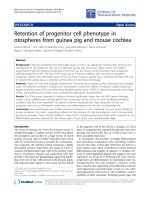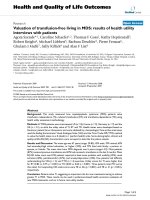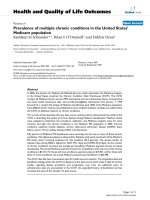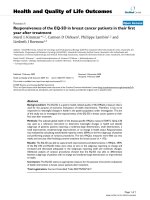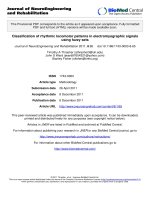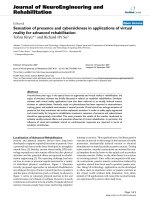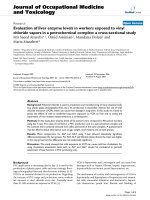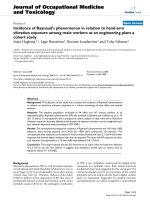báo cáo hóa học: " Accuracy of peak VO2 assessments in career firefighters" doc
Bạn đang xem bản rút gọn của tài liệu. Xem và tải ngay bản đầy đủ của tài liệu tại đây (200.99 KB, 6 trang )
RESEARCH Open Access
Accuracy of peak VO2 assessments in career
firefighters
Dana C Drew-Nord
1*
, Jonathan Myers
2
, Stephen R Nord
3
, Roberta K Oka
4
, OiSaeng Hong
1
and Erika S Froelicher
5
Abstract
Background: Sudden cardiac death is the leading cause of on-duty death in United States firefighters. Accurately
assessing cardiopulmonary capacity is critical to preventing, or reducing, cardiovascular events in this population.
Methods: A total of 83 male firefighters performed Wellness-Fitness Initiative (WFI) maximal exercise treadmill tests
and direct peak VO
2
assessments to volitional fatigue. Of the 83, 63 completed WFI sub-maximal exercise treadmill
tests for comparison to directly measured peak VO
2
and historical estimations.
Results: Maximal heart rates were overestimated by the traditional 220-age equation by about 5 beats per minute
(p < .001). Peak VO
2
was overestimated by the WFI maximal exercise treadmill and the historical WFI sub-maximal
estimation by ~ 1MET and ~ 2 METs, respectively (p < 0.001). The revised 2008 WFI sub-maximal treadmill
estimation was found to accurately estimate peak VO
2
when compared to directly measured peak VO
2
.
Conclusion: Accurate assessment of cardiopulmonary capacity is critical in determining appropriate duty
assignments, and identification of potential cardiovascular problems, for firefighters. Estimation of cardiopulmonary
fitness improves using the revised 2008 WFI sub-maximal equation.
Background
Every 23 seconds a fire in the United Sta tes requires the
services of a career or volunteer fire department [1].
Sudden cardiac death is the most common cause of on-
duty death among firefighters and occurs at higher rates
than those found in similar occupations, such as police
and emergency medical services [2].
A joint task force of the International Association of
Firefighters (IAFF) and International Association of Fire
Chiefs developed the Fire Service Joint Labor Manage-
ment Wellness-Fitness Initiative (WFI) in 1997. Revi-
sions in the 1999 and 2008 WFI recognize the
firefighter as the “most important asset” inthefireser-
vice, and its intent is to improve firefighter function, on-
duty effectiveness, and overall quality of life, while redu-
cing morbidity and mortality related to fire fighting [3].
A major component of the WFI is assessment of fire-
fighters’ cardiopulmonary capacity, with a stepmill test,
sub-maximal, or a maximal exercise treadmill test. The
WFI mandates that firefighters have a maximal exercise
test at age 40 and every other year thereafter. The maxi-
mal exercise test is intended to measure peak VO
2
(measured as ml/kg
-1
·min
-1
), which is an objective, clini-
cal measure that defines the limits of cardiopulmonary
function. Peak VO
2
reflects an individual’sabilityto
increase their heart rate and stroke volume, and redirect
oxygenated blood to muscles for work on demand. Exer-
cising at level s beyond which the cardiopulmonary sys-
tem can adequately supply oxygen (commonly termed
the anaerobic or ventilatory threshold, or VT) involves
progressively greater degrees of oxygen-independent
muscle metabolism, which is dramatically less efficient
than aerobic metabolism, and can compromise cardio-
vascular function [4].
Quantifying the energy demands of firefighting during
fire suppression is difficult due to the inherent dangers
of fire suppression tasks. Most efforts to define the
arduous physical work demand requirements during
firefighting have been focused on establishing the level
of metabolic equivalents (METs) (1 MET ≈ 3.5 ml of
O
2
/kg/min) using simulated tasks. A MET is a multiple
of the resting metabolic rate and is commonly estimated
using standardized equations [4]. 10 METs is roughly
equivalent to jogging a 10-minute mile; 14 METs is
* Correspondence:
1
Department of Community Health Systems, School of Nursing, University of
California, 2 Koret Way, San Francisco, California 94143, USA
Full list of author information is available at the end of the article
Drew-Nord et al. Journal of Occupational Medicine and Toxicology 2011, 6:25
/>© 2011 Drew-Nord et al; licensee BioMed Central Ltd. This is an Ope n Access article distributed under the terms of the Creative
Commons Attribution License (http://creativeco mmons.org/licenses/by/2.0), which permits unrestricted use, distribution, and
reproduction in any medium, provided the original wor k is prope rly cited.
similar to many extended competitive ac tivities such as
running or rowing competitively, or bicycle racing at a
high level [5]. The estimated METs proposed for fire-
fighting range from 9.6 [6] to 14 [7] (a peak VO
2
range
of 33.6 ml/kg
-1
min
-1
·to 49 ml/kg
-1
·min
-1
). Recent analy-
sis of physical aptitude tests among firefighter recruits
demonstrated that male recruits’ average VO
2
require-
ment was 38.5 ml/kg
-1
·min
-1
(11 METs) to complete a
timed simulated firefighting assessment course [8]. Mea-
surement of functional capacity in 23 firefighters sug-
gested that a mean of 41.54 ml/kg
-1
·min
-1
(11.9 METs)
is required to complete standard fire suppression tasks
while wearing personal protective equipment [9].
Firefighting work demands can be extreme and accu-
rate assessment of cardiopulmonary status, as well as
detection and treatment of any underlying cardiovascu-
lar disease, is critical to insure firefighter fitness for duty
and prevent on-duty cardiac events or death. The 1999
WFI sub-maximal exercise test was found to overesti-
mate true peak VO
2
in individual firefighters [10]. Con-
cern about overestimation led to a revised equation for
estimating peak VO
2
from sub-maximal exercise tread-
mill tests in the 2008 WFI.
Materials and methods
Given that previous sub-maximal exercise test results in
the WFI were shown to overestimate peak VO
2
,andthat
the WFI maximal exercise treadmill protocol has not
been validated for accurac y in the literature, this study
was undertaken to assess the validity of both the maximal
and revised sub-maximal exercise treadmill peak VO
2
estimates in firefighters. Specifically, the present study
tested the following comparisons: (a) estimated maximal
heart rate (220 - age) to actual measured maximal heart
rate; (b) WFI maximal exercise estimated peak VO
2
to
directly measured peak VO
2
;c)averagedpre-revision
sub-maximal estimated peak VO
2
to revised sub-maximal
estimated peak VO
2
; and (d) directly measured peak VO
2
to revised WFI sub-maximal estimated peak VO
2
.
Study Setting and Participants
The study setting was a medium-sized suburban fire
department in the eastern region of the San Francisco
Bay Area in northern California. This department serves
approximately 163,000 citizens and covers 46 square
miles. All firefighters (N =105)assignedtosuppression
duties were recruited, including firefighters, firefighter/
paramedics, firefighter/engineers, firefighter/captains and
battalion chiefs. There were no women suppression fire-
fighters in the department studied. This is consistent
with national career firefighter statistics as women only
represent approximately 4.5% of the fire service [11]. All
testing took place during a five-week period between
December 2008 and January 2009.
Inclusion criteria for participation required that each
participant had successfully completed a WFI examina-
tion within the previous nine months and achieved a
minimum of 10 METs (peak VO
2
of 35 ml/kg/min), on
either a sub-maximal (using the pre-2008 equation), or
maximal exercise treadmill test. Exclusion criteria
included injury, illness, or scheduling conflicts that pre-
cluded testing during the study period. The final study
pop ulation consi sted of 83 male career firefighter s from
all suppression ranks in this department.
The study was conducted with approval of the Univer-
sity of California San Francisco Committee on Human
Research. Signed informed consents were obtained and
all testing was conducted during on-duty hours with the
approval of the department and union local.
Testing occurred at an occupational health clinic
where previous WFI examinations for this fire depart-
ment had been conducted. A physician board certified
in internal medicine and occupational medicine, and a
nurse practitioner experienced in exercise testing, per-
formed all treadmills and direct VO
2
measurements.
Participants arrived on the day of scheduled testing with
their assigned duty crew, with gym clothes and runn ing
shoes appropriate for completing a maximal exercise
test.
Measurements
Data collection consisted of medical record abstraction
for demographics, cardiovascular risk factors and exer-
cise test information. Demographic characteristics
included age, rank, and years of fire service. Definitions
of cardiovascular risk factors were obtained from the
American Heart Association, Adult Treatment Panel III
(ATP III), The Seventh Report of the Joint National
Committee on Prevention, Detection, Evaluation and
Treatment of High Blood Pressure (JNC7), and the Cen-
ters for Disease Control and Prevention [12-15]. All
serum samples were analyzed at the same hospital-based
certified laboratory (Centers for Medicare and Medicaid
Services Clinical Laboratory Improvements Amend-
ments (CLIA)). Cardiovascular risk factors of the partici-
pants are summarized in Table 1.
Maximal Heart Rates
Maximal estimated heart rates were calculated as 220-
age. Directly measured maximal heart rates were deter-
minedfromtheelectrocardiogramatthepointofvoli-
tional fatigue as determined by the firefighter and
corroborated by the direct VO
2
assessment indicating
that they had crossed the VT.
Maximal Exercise Treadmill with Direct Peak VO
2
Assessment
All 83 participants completed a maximal exercise test
using the 2008 WFI Protocol with concurrent direct
peak VO
2
measurements. Maximal exercise treadmill
Drew-Nord et al. Journal of Occupational Medicine and Toxicology 2011, 6:25
/>Page 2 of 6
tests were considered complete when the firefighter
indicated volitional fatigue (n = 83, see above), or if ter-
minated by the testing physician due to concerns about
cardiopulmonary distress (n = 0). The WFI protocol is a
modified ramp protocol comprised of a 3-minute warm-
up period at 3 mph - 0% grade, followed by fifteen 1-
minute stages. Stage 1 begins at 4.5 mph and 0% grade,
with the treadmill incline increasing 2% and speed
increasing by 0.5 mph alternately in stages 2 through
15. The WFI maximal exercise treadmill estimates peak
VO
2
based on the American College of Sports Medicine
metabolic equation for running [16].
Peak VO
2
was obtained using the Cardio Coach
CO
2
™ VO
2
Fitness Assessment System, Model 9001-
RMR (Korr Medical Technologies, Salt Lake City,
Utah). The Cardio Coach CO
2
™ is an economical,
portable metabolic testing device that is feasible for
use in a clinic and has been previously validated for
measurement of peak VO
2
levels [17,18]. The Cardio
Coach CO
2
TM is
a dual gas analyzer (O
2
and CO
2
)that
automatically calibrates to standar d temperature and
pressure, dry at the beginning o f each testing cycl e.
The Cardio Coach CO
2
™ measures heart rate using
the Polar T-31 heart monitor (Polar, I nc., Lake Suc-
cess, NY). Heart rate and VO
2
(ml/kg
-1
·min
-1
), VCO
2
(ml/kg
-1
·min
-1
), VE/VO
2,
VE/VCO
2
,VEinL/min,
FeO
2
%, Fe CO
2
%, and respiratory exchange ratio are
graphically reported every 15 seconds. The Cardio
Coach CO
2
™ uses the ventilatory equivalents method
(Ve/VO
2
) to detect VT (Korr Medical Technologies,
2009).
Revised Sub-maximal Exercise Treadmill Assessments
In the latter part of 2008, the WFI introduced a revised
equation for estimating peak VO
2
:peakVO
2
= 56.981 +
(1.242 × TT) - (0.8 05 × BMI), where TT is the test time
required to achieve target heart rate, and BMI is Body
Mass Index. The 2008 WFI calculates target sub-maxi-
mal heart rate (208 - (0.7 × age) × 0.85, whereas pre-
vious sub-maximal heart rates were based on (220-age)
× 0.85 [3,19].
Of the 83 firefighters who volunteered for the maxi-
mal exercise treadmill tests and directly measured peak
VO
2
, 63 subsequently completely their annually sched-
uled WFI examination, which included a sub-maximal
exercise treadmill test, within the subsequent four to
eight weeks. These subsequent WFI sub-maximal exer-
cise treadmill tests, using the revised equation, took
place under identical conditions as the study WFI maxi-
mal exercise treadmill tests but without the direct VO
2
measurement. The sub-maximal test uses the WFI
treadmill protocol (see above) but terminates 15 seconds
after the firefighter reaches their target heart rate.
Pre-revision Sub-maximal Exercise Treadmill Assessments
Prior to the 2008 WFI revision there was no published
equation for the estimation of peak VO
2
from the sub-
maximal exercise treadmill. The estimated peak VO
2
was determined by duration of the test and stage
achieved [19]. Between one and seven historical sub-
maximal test results were available for each of the 63
participants, and were averaged to create comparative
historical variables.
Procedure
Participant’s height, weight and resting blood pressure
was measured. A resting electrocardiogram (ECG) was
completed, using the Welch-Allyn Schiller AT-10 6-
Channel electrocardiograph/treadmill (San Diego, Cali-
fornia). Upon completion of the resting ECG the Mason-
Likar lead configuration was modifi ed to accommodat e
the exercise treadmi ll [4]. The participant was then fitted
with the appropriate 2-way non-rebreathable mask
(Hans-Rudolph, Inc., Shawnee, Kansas). The mask com-
pletely covered the nose and mouth of the participant
and was checked for air leaks to eliminate extraneous
room air from affecting the interpretation of peak VO
2
.
A standing electrocardiogram was obtained and the
treadmill was initiated. At test termination the firefigh ter
recovered in the supine position. Available data from the
maximal exercise treadmills is detailed in Table 2.
Statistical Analyses
Prior to all analysis all data were examined using stem
and leaf plots and found to have normal distribution.
Table 1 Participant Cardiovascular Risk Factor Profile -
Maximal Exercise Treadmill-Peak VO
2
Assessment (n = 83)
Risk Factor Mean, SD
Body Mass Index (kg/m
2
) 28.2 (± 3.9)
Systolic BP 117 (± 10)
Diastolic BP 69 (± 7)
Total Cholesterol* (mg/dL) 197 (± 38)
HDL** (mg/dL) 47 (± 11)
LDL** (mg/dL) 126 (± 36)
Cholesterol/HDL Ratio 4.35 (± 1.17)
Triglycerides (mg/dL) 118 (± 70)
*-fasting
**- HDL - high density lipoprotein; LDL - low density lipoprotein
Table 2 Maximal Exercise Treadmill Data (n = 83)
Minimum Maximum Mean, SD
Resting Systolic 102 164 122 (±10)
Resting Diastolic 60 100 73 (±8)
Resting Heart Rate 42 91 63 (±10)
Maximal Heart Rate 130 194 174 (±10)
Peak VO
2
Actual 26.3 69.5 43.6 (±9.1)
RER* - Peak Exercise 0.90 1.28 1.09 (± .07)
* - Respiratory Exchange Ratio
Drew-Nord et al. Journal of Occupational Medicine and Toxicology 2011, 6:25
/>Page 3 of 6
Dependent t-tests were conducted on all 83 participants
to test for differences between:
1) Estimated maximal heart rate (220 - age) and
directly measured maximal heart rate.
2) WFI maximal exercise treadmill estimated peak
VO
2
and directly measured peak VO
2
.
Additional dependent t-tests were conducted on the
results of the 63 participants who subsequently per-
formed a revised WFI sub-maximal exercise treadmill
test for differences between:
1) Averaged pre-revision WFI sub-maximal exercise
treadmill estimated peak VO
2
mean (converted to
METs) to revised WFI sub-maximal exercise tread-
mill estimated peak VO
2
(converted to METs).
2) Directly measured peak VO
2
(converted to METs)
to revised WFI sub-maximal exercise treadmill esti-
mated peak VO
2
(converted to METs).
All dependent t-tests were two tailed, with a =0.05
used for statistical significance. Statistical analyses were
performed using SPSS Version 15.0 (SPSS, Inc., Chicago,
Illinois).
Results
There were 105 active suppression male career firefigh-
ters eligible for participation in the study. Of those, five
were new hires who had not completed a WFI examina-
tion. Six firefighters chose not to participate; of the 94
choosing to participate 11 could not be scheduled for
maximal exercise tests due to injury, illness or schedul-
ing conflicts resulting in an n =83forthisstudy.The
participants’ ages ranged from 26 to 57 years with a
mean of 41.1; 94% of the participants were Caucasian,
and 6% were Hispanic or African-American. The years
of firefighting ranged from 2 to 34 with a mean of 15.6.
Maximal Estimates and Measurements
The traditional maximal heart rate estimation (220 -
age) was significantly higher than measured maximal
heart rate (178.6 vs. 173.6 with a mean difference of
4.96 beats/min, p < 0.001, 95% CI: 3.03, 6.90). Estimated
peak VO
2
was significantly higher than directly mea-
sured peak VO
2
(47.7 vs. 43.6, with a mean difference of
4.06 ml/kg/min, (1.16 METs) p < 0.001, 95% CI: 2.88,
5.23).
Sub-maximal Estimates and Measurements
Within four to eight weeks of the maximal exercise
treadmill tests 63 participants completed a sub-maximal
exercise treadmill test (using the revised 2008 WFI
equatio n). Their average age was 40.19 years (± 6.9) and
average years of firefighting was 14.4 (± 6.8). All firefigh-
ter suppression ranks were represented in this sub-
group. The subsequent examination allowed for compar-
ison of the revised sub-maximal exercise treadmill peak
VO
2
estimate to an averaged pre-revision (comparative
historical variable) sub-maximal exercise treadmill peak
VO
2
estimate and the recently obtained directly mea-
sured peak VO
2
. For simplicity in reporting sub-maxi-
mal results all peak VO
2
results were convert ed to
METs (peak VO
2
/3.5).
A statistically significant difference was found between
pre-revision sub maximal exerci se treadmill peak METs
mean estimates and revised sub-maximal peak METs
estimates (14.81 vs. 12.58, with a mean difference of
2.23 METs, p < 0.001, 95% CI: 1.86, 2.59) These findings
support previous research determining that WFI sub-
maximal peak METs estimates prior to the 2008 revi-
sion were overestimated [10]. Revised sub-maximal
treadmill METs estimates did not differ from directly
measured maximal exercise treadmill METs, indicating
that the revised 2008 estimating equation is a reasonable
estimate of METs (12.64 vs. 12.58 with a mean differ-
ence of .07 METs, p ≤ .76, 95% CI: 39, .54) This repre-
sents additional validation of the accuracy of the new
estimating equation [3]. All maximal and sub-maximal
comparisons are summarized in Table 3.
Discussion
Fire departments often struggle to determine fitness for
duty for their members who return from an injury or ill-
ness, prepare to embark on wildland strike teams, heavy
rescue missions, or for daily work assignments. There
are ongoing efforts to define minimally acceptable and
safe fitness levels; levels that should be informed by the
energy requirements needed during a firefighter’stour
of duty. Maximum directly measured METs for the fire-
figh ters in this study ranged from 7.5 to 19.9, indicating
that some participants might have a difficult time meet-
ing the demands of the job while others appear ade-
quately fit. Four different methods of cardiopulmonary
assessment are compared here: direct measurement of
peak VO
2
, estimated peak VO
2
derived from a maximal
exercise treadmill equation, historical average of pre-
revision estimated peak VO
2
sub-maximal exercise
treadmills, and estimated peak VO
2
derived from the
rev ised (2008) sub-maximal exercise treadmill equation.
Directly measured peak VO
2
is the most objective and
considered the “gold standard” of the four methods [4].
The difference observed in maximum heart rate
between directly me asured maximum heart rate (while
wearing a non-rebreathable mask), and a 220-age esti-
mated maximum heart rate (part of the maximal exer-
cise treadmill estimation equation) provides some
explanation for the over-estimation. Estimated maximal
Drew-Nord et al. Journal of Occupational Medicine and Toxicology 2011, 6:25
/>Page 4 of 6
heart rates were about 5 beats per minute higher than
those measured during peak exercise. H eart rates are a
method used on the fire ground to evaluate a firefigh-
ters’ capability to re-enter the fire scene. Using target
heart rates that exceed true maximums, or percentages
of estimated maximum heart rates that are inaccurate,
could result in dangerous duty assignments.
Assessment of direct peak VO
2
and maximal exercise
treadmill results indicate that the equation utilized by
the WFI maximal treadmill over-estimates peak VO
2
by
an average of 4.06 ml/kg
-1
·min
-1
, or approximately 1
MET. If a firefighter’ s fitness level is less than optimal,
or if they have underlying cardiovascular disease, this
overestimation could lead to on-duty clearances that
could prove compromising.
Revised sub-maximal ex ercise treadmill peak VO2
estimates were compared to averaged pre-revision his-
torical sub-maximal exercise peak VO
2
estimates. The
average overestimation of the historical mean was
approximately 2 METs. This finding supports the Mier
andGibsonreport(2004)thatthepre-revisionWFI
sub-maximal treadmill equation overestimated peak
VO
2
, and that those equation results should be used
with caution for duty assignment decisions.
The comparison of directly measured peak VO
2
to the
revised sub-maximal exercise treadmill peak VO
2
esti-
mates (n = 63) found that there were no differences
between the two assessment methods. When comparing
revised WFI sub-maximal exercise treadmill peak VO
2
estimates to previous years of testing, or to reports in
the literature, careful consideration must be given to
which estimation method was used. The same task,
measured with different estimating equations, can result
in different results as demonstrated herein.
Limitations and Strengths
The limitations of our study include the self-selection
bias of the participants, the limited gender and ethnic
demographics of the group (all male, predominantly Cau-
casian), and the range in number of historical sub-
maximal exercise treadmill VO
2
estimates, resulting in a
less than ideal comparison g roup. While testing was
completed within a four month period, it included the
winter holiday season which may have had a seasonal
influence on fitness behavior (resulting in an increase or
decrease in exercise intensity). The composition of the
sample is reflective of the department in terms of gender
and ethnicity. There is an average four to eight week gap
between the direct measure peak VO
2
and the sub-maxi-
mal exercise treadmill peak VO
2
assessment without any
documentation of fitness behaviors. Ho wever, any fitness
improvement on the part of firefighters in the interim
would have directed the results towards the null.
The strengths of our study include the number of parti-
cipants, their range in age, rank, firefighting experience,
and their experience with the WFI protocol. The avail-
ability of seven years historical data can be viewed as a
strength. Use of the mask to measure peak VO
2
was
familiar to the participants as they routinely work with
self-contained breathing apparatus. The ability to per-
form all testing components w hile on duty encourage d
participation. There were no incentives of fered for parti-
cipation. All testing was completed in the same facility
using the same equipment and personnel, thus increasing
consistency of testing and inter-rater reliability.
Clinical Implications
Firefighters who have been tested using earlier estimation
equations may requ ire careful explanation as to a notice-
able drop in test results when using the revised 2008 WFI
equation. Participants are likely to be disappointed to see a
reduction in their “fitness level” when they have not chan-
ged their patterns, nor workout habits, between testing
cycles. Again, if a fire fighter falls into the lower fitness
categories, or has underlying cardiovascular disease, inac-
curate estimates could contribute to cardiac compromise.
Conclusions
In order to protect firefighters from potentially life-
threatening cardiac situations it is imperative that
Table 3 Comparisons: Heart Rate, Peak VO
2
, Estimated METs
n Mean SD SEM 95% CI Lower 95% CI Upper t d Sig(2-tailed)
Estimated Max.
HR: Actual Max. 83 4.96 8.87 .97 3.03 6.9 5.09 82 .00
HR
Estimated peak
VO
2
: Direct
measure peak VO
2
83 4.06 5.39 .59 2.88 5.23 6.85 82 .00
Pre-revision METs
Est.: Revised METs estimate 63 2.23 1.46 .18 1.86 2.59 12.14 62 .00
Direct METs:
Revised Sub-maximal METs estimate 63 .07 1.85 .23 39 .54 .31 62 .76
Drew-Nord et al. Journal of Occupational Medicine and Toxicology 2011, 6:25
/>Page 5 of 6
exercise testing r esults are accurate, whether the test is
being used for duty assignment or part of a comprehen-
sive risk assessment. The results from the revised sub-
maximal exercise treadmill estimation equation appear
to accurately reflect directly measured peak VO
2
results.
WFI maximal treadmill peak VO
2
estimates should be
interpreted with caution, especially as they appear to
over-estimateMETsbyanaverageof1.Giventhe
potential for over-estimationoffitness,providerswho
make fitness-for-duty assessments should consider the
energy requirements of the job, any underlying cardio-
vascular risk factors, and the method of testing used
when recommending return to, or continuation of,
duties. These findings support the continuation and
further expansion of reliable exercise testing of firefigh-
ters, within the context of a cardiovascular disease pre-
vention program such as the WFI.
Performing measured peak VO
2
and maximal exercise
treadmill tests can be challenging for fire departments
to accomplish due to limited resources. The 2008 WFI
sub-maximal exercise t readmill test can be safely admi-
nistered outside of a medical setting using tools that are
often available within the fire department (treadmill,
stopwatch, and Polar heart monitor). Disadvantages of
the sub-maximal treadmill test are the limited means for
assessing underlying cardiovascular conditions, and the
inability to determine maximal cardiovascular perfor-
mance directly. However, the revised 2008 sub-maximal
treadmill peak VO
2
estimation equation is a valid tool
to assess interim progress in cardiovascular training
programs.
Acknowledgements
The corresponding author would like to thank the Livermore-Pleasanton Fire
Department administration, suppression, and support staff for their trust,
enthusiasm, and participation in this project; the National Institute for
Occupational Safety and Health (Grant #T42 OH 008429) for its traineeship
support; and the UCSF School of Nursing Century Club for its financial
support.
Author details
1
Department of Community Health Systems, School of Nursing, University of
California, 2 Koret Way, San Francisco, California 94143, USA.
2
School of
Medicine, Stanford University, Palo Alto VA Health Care System, 3801
Miranda Avenue, Palo Alto, California 94304-1290, USA.
3
Premier COMP
Medical Group, Inc. 5635 W. Las Positas Blvd., Suite 401, Pleasanton, CA
94588, USA.
4
Palo Alto VA Health Care System, 3801Miranda Avenue, Palo
Alto, California 94304-1290, USA.
5
Department of Physiological Nursing,
School of Nursing, University of California, 2 Koret Way, San Francisco,
California 94143, USA.
Authors’ contributions
All of the authors contributed substantially to the conception, design, data
acquisition and analysis, manuscript drafts and revisions of this study. Each
has given final approval for publication.
Competing interests
Dr. Drew-Nord and Dr. Nord own the occupational medicine practice where
this research was conducted and contract with various fire agencies to
provide WFI services. This relationship was determined to represent no
conflict of interest by the Institutional Review Board of the University of
California, San Francisco. The remaining authors declare that they have no
competing interests.
Received: 6 October 2010 Accepted: 25 September 2011
Published: 25 September 2011
References
1. Firefighter Statistics. [ />index.shtm], retreived August 3, 2011.
2. United States Fire Administration: Firefighter Fatality Retrospective Study,
April 2002/FA-220.Edited by: Corporation T: Firefighter Fatality
Retrospective Study 2006.
3. Fire Service Joint Labor Management Wellness-Fitness Initiative. [http://
www.iaff.org/HS/Well/wellness.html].
4. Froelicher VF, Myers J: Exercise and the heart. Philadelphia: Saunders
Elsevier;, 5 2006.
5. Fletcher GF, Froelicher VF, Hartley LH, Haskell WL, Pollock ML: Exercise
standards. A statement for health professionals from the American Heart
Association. Circulation 1990, 82:2286-2322.
6. Sothmann MS, Saupe K, Jasenof D, Blaney J: Heart rate response of
firefighters to actual emergencies. Implications for cardiorespiratory
fitness. J Occup Med 1992, 34(8):797-800.
7. Malley KS, Goldstein AM, Aldrich TK, Kelly KJ, Weiden M, Coplan N,
Karwa ML, Prezant DJ: Effects of fire fighting uniform (modern, modified
modern, and traditional) design changes on exercise duration in New
York City Firefighters. J Occup Environ Med 1999, 41(12):1104-1115.
8. Williams-Bell FM, Villar R, Sharratt M, Hughson RL: Physiological demands
of the firefighter candidate physical ability test. Medicine and Science in
Sports and Exercise 2009, 41:653-662.
9. Adams J, Roberts J, Simms K, Cheng D, Hartman J, Bartlett C: Measurement
of functional capacity requirements to aid in the development of an
occupation-specific rehabilitation training program to help firefighters
with cardiac disease safely return to work. American Journal of Cardiology
2009, 103:762-765.
10. Mier CM, Gibson AL: Evaluation of a treadmill test for predicting the
aerobic capacity of firefighters. Occup Med (Lond) 2004, 54(6):373-378.
11. Women in the fire service. [ />categoryID=955&itemID=23601&URL=Research/Fire%20statistics/The%20U.S.
%20fire%20service&cookie%5Ftest=1], retrieved August 3, 2011.
12. Men and cardiovascular disease risk factors. [ />HEARTORG/Conditions/HeartAttack/UnderstandYourRiskofHeartAttack/
Understand-Your-Risk-of-Heart-Attack_UCM_002040_Article.jsp], retrieved
August 3, 2011.
13. Healthy weight - it’s not a diet, it’s a lifestyle!. [ />healthyweight/assessing/bmi/adult_bmi/index.html#Interpreted].
14. Third report of the expert panel on detection, evaluation, and treatment
of high blood cholesterol in adults (ATP III). [ />atpiii/calculator.asp?usertype=prof].
15. National Institute of Health National Heart Lung and Blood Institute: JNC7
Guidelines. 2006.
16. American College of Sports Medicine: Guidelines for exercise testing and
prescription. Baltimore: Lippincott, Williams & Wilkins;, 6 2000.
17. Jensky NE, Vallejo AF, Ong MD, Schroeder ET: Validation of the Cardio
Coach for sub-maximal and maximal metabolic exercise testing. Medicine
and Science in Sports and Exercise 2005, 37(5):S231.
18. Dieli-Conwright CM, Jensky NE, Battaglia GM, McCauley SA, Schroeder ET:
Validation of the CardioCoach CO2 for submaximal and maximal
metabolic exercise testing. The Journal of Strength and Conditioning
Research 2009, 23:1316-1320.
19. International Association of Fire Fighters: The Fire Service Joint Labor
Management Wellness-Fitness Initiative. Washington, D.C.: International
Association of Fire Fighters;, 2 1999.
doi:10.1186/1745-6673-6-25
Cite this article as: Drew-Nord et al.: Accuracy of peak VO2 assessments
in career firefighters. Journal of Occupational Medicine and Toxicology 2011
6:25.
Drew-Nord et al. Journal of Occupational Medicine and Toxicology 2011, 6:25
/>Page 6 of 6
